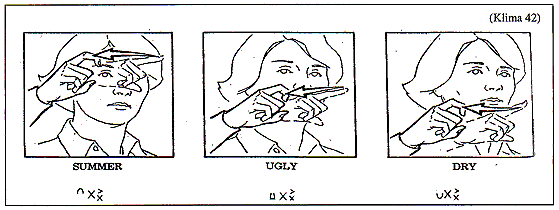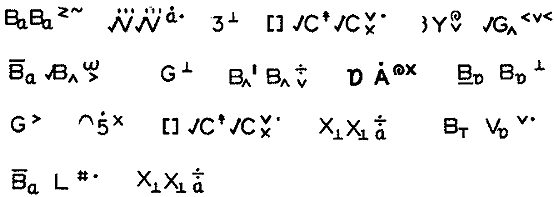Two Notation Systems for Signed Languages: Stokoe Notation & Sutton SignWriting Joe Martin Western Washington University Martinj4@cc.wwu.edu |
||||||||||||
|
Any writing system stresses some parts and ignores others, and therefore is an analysis, one that reflects the biases and assumptions of its creator. Thus, part of analyzing any script, it is important to examine how and why it was created. William Stokoe Then, just like any linguist analyzing a new language, he looked for "minimal pairs." A minimal pair is two words that differ only in one segment, for example Rode and Rude. These are two different words only because the second segment is different. This tells us that [u] and [o] are two different sound-segments in English, and we need to use different symbols for them. If changing a detail results in changing the meaning, then that detail is important. Changing our loudness or the color of our socks wouldn't change the meaning; that's why no writing system includes the color of our socks. In fact, these two words Rude and Rode are different in only one phonetic feature - that of Tongue Location (Height). Setting the Location of the tongue "high" produces the [u] sound and setting it lower produces the [o] sound. Changing the setting of that one parameter, Location, changes the segment to the other; Rude becomes Rode. Specifically this depends on the position of the articulator- the tongue in this case. Stokoe showed that Location is a parameter in ASL even though the articulator is the hand rather than the tongue. Figure 5 shows three words that are exactly the same except for Location. Performing the illustrated movement on the chin location means "dry," performing the exact same movement on the lip means "ugly." Structurally, this is identical to changing tongue height to produce the English sounds [u], [o], and [a].
Using this accepted reasoning, Stokoe proved that each sign has the three parameters of Location, Movement and Hand Shape. His symbols for these are shown as the SN "characters" underneath each picture in Figure 5. Notice how each character includes three different kinds of symbols, corresponding to the three parameters. Location is shown by the first symbol, and since Location is the only difference between these three signs, that is also the only part of the characters that are different. At this point Stokoe's job was done. He had proven that ASL was structured like all other human languages, with parameters and features, and illustrated this with his newly invented script. See Figure 5a.
|
||||||||||||
|

